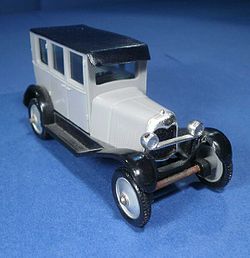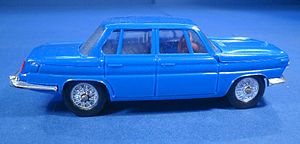- Minialuxe
-
Minialuxe was a brand of plastic car and truck models made in Oyonnax (Department of Ain), France, usually in 1:43 scale, but some larger 1:32 scale vehicles were also manufactured (like a Peugeot 403). The official name in French was 'Establissments Minialuxe'.
Contents
History
Minialuxe started production of plastic cars about 1954 (some sources say 1959) and ceased production in the late 1970s (Ford Anglia website; Ralston and Forbes 2008, p. 26). The company was based in the town of Oyonnax in eastern France about 20 miles from Geneva, Switzerland, and about 50 miles northeast of Lyon (where toy makers Norev and Majorette were headquartered). Oyonnax was known for its plastics industry, with experimentations before WWII and a new burgeoning industry post-War (Ralston and Forbes 2008, p. 25).
Models featured were mostly, but not exclusively, French makes (Sinclair's 1977). There were two main series, a contemporary line and a classic line. Minialuxe appears to have started with the contemporary line, expanding into the classic line around 1970. Collectors often seem more interested in the unique selections of the classic series, but all models, though somewhat simpler than zamac diecast, were clever and included details that were quite endearing.
The Contemporary Line
The contemporary line was started in the early 1960s and continued to the mid 1970s. It featured mainly Renaults (Ondine, Floride, 10,16, Alpine A310, 5, and 17), Peugeots (203, 204, 403, 404, 504, and 604), Citroens (11CV Traccion Avant, Ami sedan and break, Dyane, Mehari, DS19, DS21, SM, CX, and GS), Simcas (Aronde, 1100, 1300, Oceane, and Plein Ciel). For plastic, the selection and detail were impressive. Less popular French brands from the 1950s through the 1970s such as the Hotchkiss Gregoire, Panhards, and Matras were also available. Several models were offered in police livery. The Hotchkiss (and other cars) were available with various trailers or features such as luggage, skis, or a canoe affixed to the roof. The Citroen 11CV fourgon (delivery van) was also offered for several years, especially in police livery (Minialuxe Forum website).
Other non-French makes were a significant part of the line-up. A couple of Volvos, Porsche 911 Targa, Mercedes W196 Grand Prix car, Jaguar E-Type and D-type, a Ford GT Mark IV, a FIAT 124 and a Siata-Fiat were included. European Fords (Consul, Anglia and Taunus), a VW K70, a BMW 1500, and a Vespa 2CV rounded out the offerings. Formula 1 race cars such as a Matra MS80, Ferrari 312B, and a Gordini added extra sport to the line.
Multiple car gift sets were offered, for example, six Citroen Traccion Avants in six different colors in one box, or a BP station with pumps and repair jack. Many of these more contemporary Minialuxe models were part of sweepstakes offers or used as promotionals for different companies. For example "Cheque Tintin" was a sweepstakes offer based on the comic strip The Adventures of Tintin (Les Aventures de Tintin) where one accumulated coupons or stamps out of magazines and other publications and turned in for model cars. Another example was a Citroen DS19 sedan with "Vetements Bayard" (Bayard Clothing) imprinted (partially melted into the plastic) on the roof.
Minialuxe also made a few motorcycles, some buses, and a couple of trucks.
The Classic Line
The classic Minialuxe "Les Tacots" line was started about 1970, after the contemporary line had been in production for almost a decade. The classic line featured 34 vehicles from about 1900 through the 1920s. French vehicles were the most common and included Renaults, Peugeots, Citroens, Panhards and others like a Lorraine-Dietrich, a Balda, a Park Royal, and a De Dion. David Sinclair, who was probably the first to import Minaluxe models to the United States, noted that one interesting selection was a Panhard & Levassor that was one of the first automobiles and one of the earliest cars enclosed in glass (Sinclair's 1977; Levine 2009). A few non-French American cars like variants of the Ford Model T, an early Packard landaulet, the first Oldsmobile curved dash model, and an Autocar taxi were offered. British models produced were an early Austin delivery van and a Lanchester.
Models were all plastic, but this was ideal for the intricate 'spiderweb' details needed for thin window supports and long narrow wheel spokes seen on early classic cars. The Minialuxe classic line was contemporary to and similar to early Brumm or Rio Models which were also plastic. Some models, like the 1910 Renault came in different forms and sometimes had holes in the plastic where windshield or other pieces were placed on other variants - which gives the appearance that parts are missing when they are not. While most models appeared well-constructed, some appeared with glue sloppily streaked across body panels.
A small series of HO Tacot models were also introduced but Force says that only four were apparently made (Force 1991, p. 150). One very intriguing Minialuxe model was a Hill's 1839 primitive locomotive, similar to George Stevenson's first locomotive built in Newcastle in 1829.
Model Details
Minialuxe models had both bodies and chassis made of styrene plastic. Early Minialuxe models were fairly simple without windows, had simple chassis, and sometimes one piece tire/wheel assemblies. Later models were more precisely detailed sometimes with two-tone paint schemes and some opening features (Force 1991, p. 149). Usually the only metal parts were axles. Earlier cars had bumpers and chrome parts hand painted in silver while headlights and tail lights were often painted with yellows and reds.
By 1968 or 1969 interiors, steering wheels, opening hoods and engine detail had all been added on various models (Force 1991, p. 149). Earlier engine detail was painted silver and later, chromed. For example, the Simca 1100 sedan had an opening hood and tail gate. Some models experienced glue distortion under roofs or warping of bodies over time, which is unusual for styrene. Wheels were a solid, but handsome chrome spoke pattern. Tires were a slightly softer polyurethane. By the 1970s, bodies were better formed with pieces fitting together much better (Force 1991, p. 150).
Models were mostly unnumbered in the contemporary line, while the "Tacots" classic line was numbered. As a case study, on the black plastic base of the BMW 1500 sedan was written the name of the car and "1:43" then "Minialuxe" in large letters. Below that it said "Minia Stable" (steady minialuxe?) possibly referring to the workable suspension - and below then "suspension brevetee SGDG"(meaning 'patented'). The chassis was cut along lines parallel with the length of the car which subsections were supported around the axles giving a springy bounce to the car. Lastly, of course, was "Made in France" (Force 1991, p. 149).
Packaging
Early Minialuxe vehicles came in simple cardboard cartons without plastic windows and illustrated with colorful artwork of the cars. 'Minialuxe' or 'Jouet Minialuxe' was written on the flaps commonly with the color of the car printed. Two Simcas were commonly shown on each early box, emphasizing French origins (Minialuxe Forum website). In the 1970s, similar to the German Cursor company, models were offered in a clear flimsy plastic 'box' with a cardboard base.
The Duration of Minialuxe
It appears that Minialuxe, as a rather sophisticated plastic model maker, lasted about 25 years, though it was not very well known outside of France, and less well-known than competitors like Norev. This is a longer period than several other European diecast model makers - whether made of plastic or zamac metal. For example, Minialuxe lasted longer than Italian Mebetoys and nearly as long as Polistil, both of which had more company influence (Mattel in the case of Mebetoys) and more international success. Minialuxe models were very practical and realistic and never made any concessions to Mattel's fast axle wheel developments, flashy paint, and Hot Rod hip style which revolutionized the toy car industry.
It seems as the company declined, it depended more and more on its Tacots classic series and on adult collectors who prized them. Well-known collector Edward Force says, as far as he could tell, the last 'new' model was introduced in 1974, but models may have been produced up until the later 1970s (Force 1991, p. 150). In any event, by 1980 Minialuxe was gone.
References
Ford Anglia website. Ford Anglia Models. Models by Miniluxe. [1]
Force, Dr. Edward. 1991. Classic Miniature Vehicles Made in France with price guide and variations list. West Chester, Pennsylvania: Schiffer Publishing.
Levine, R. F. 2009. David Sinclair in the Driver's Seat. Lake Erie LifeStyle, web published December 1. [2]
Miniluxe Forum website. Caradisiac. com - 1er site d'info automobile [3]
Ralston, Andrew and Mike Forbes. 2008. Plastic Toy Cars of the 1950s & 1960s: The Collector's Guide. Dorchester, England: Veloce Publishing.
Sinclair's Auto Miniatures. 1977. Typewritten newsletter, flyer focusing on Minialuxe Tacots. August. Erie, Pennsylvania.
Categories:- Model manufacturers
- Die-cast toys
- 1:43 scale models
- Promotional models
Wikimedia Foundation. 2010.



